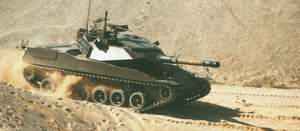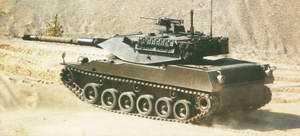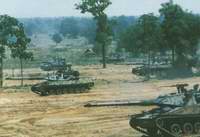| Designation: | Stingray |
 |
|---|---|---|
| Manufacturer: | Textron Marine & Land Systems | |
| Product type: | Armoured Vehicles | |
| Name: | Light tank |
The Stingray light tank was developed for the export market by Cadillac Gage Textron (now Textron Marine & Land Systems) as a private venture.
The concept phase of Stingray development started in January 1983 with actual design work beginning in September the same year. Prototype construction began in February 1984 and the vehicle, without its turret, ran for the first time in August 1984. Design work on the turret began in mid-1983, the prototype turret being completed in June 1984 and installed on an M551 Sheridan light tank chassis for trials.
The Stingray light tank was shown in public for the first time in October 1984. The prototype Stingray light tank went to Thailand for trials early in 1986 and the second prototype Stingray, which was built to production drawings, was completed in mid-1986. Early in 1987, the first prototype of the Stingray was demonstrated in Malaysia.
In October 1987, Cadillac Gage Textron signed an agreement with Thailand for the supply of 106 Stingray light tanks to the Royal Thai Army at a total cost of USD150 million. First production Stingray light tanks were completed in December 1988 and shipped direct to Thailand. Final deliveries were made early in 1990.
Production of the Stingray light tank is complete and it is no longer marketed.
The hull of the Stingray is of all-welded Cadloy steel armour with protection over the frontal arc against penetration by 14.5 mm armour-piercing rounds fired from the Russian KPVT heavy machine gun and protection against 7.62 mm armour-piercing rounds over the remainder of the vehicle.
The layout of the Stingray is conventional, with the driver's compartment at the front, fighting compartment in the centre and power pack at the rear.
The driver sits in the centre of the hull at the front and has a single-piece hatch cover that is hinged at the rear and can be locked open. The hatch cover has three integral day periscopes, which give good visibility over 120º of the vehicle's front. The centre periscope can be replaced by a passive periscope for night driving. The driver has an adjustable seat and would normally enter his position via the turret. With the turret traversed fully left or right or with the 105 mm gun in its travel lock, the driver can easily enter via his hatch.
The driver steers the Stingray with an oval steering wheel rather than the more usual sticks. Either side of the driver's position are 14 rounds of 105 mm ammunition. When in a combat area, an optional spall blanket is hung to the sides and rear of the driver's position for added protection. The Stingray has additional internal stowage space above the tracks with an access hatch in the glacis plate either side of the driver.
The Stingray suspension is of the torsion bar type and based on that fitted to the now BAE Systems, Ground Systems Division, M109 155 mm self-propelled howitzer.
The suspension either side consists of six dual rubber-tyred road wheels, drive sprocket at the rear, idler at the front and three track-return rollers, the last from the M41 light tank. The torsion bars are longer than those of the M109 and are of 166,000 psi steel with a 203.2 mm jounce, 50.8 mm rebound and bottom at 2.5 g loading. The first and last torsion bars are stiffer than the remainder and the first, second and sixth road wheel stations have a hydraulic shock-absorber.
The road arms were originally designed to carry 1,814 kg but in the Stingray carry only 1,588 kg, therefore leaving plenty of scope for additional weight, for example appliqué armour should this be required, without overloading the suspension.
The tracks are 380 mm wide and are of the double-pin type with detachable pads.
The Stingray is powered by the Detroit Diesel, Model 8V-92TA eight-cylinder diesel developing 535 bhp at 2,300 rpm. The engine is mounted crossways to make maximum use of the available space. The engine has twin turbochargers, a Roots blower and an aftercooler.
The engine is coupled to an Allison Transmission XTG-411-2A automatic transmission, which has an automatic lock-up torque converter with a torque multiplication of 2.4, geared steer and clutch and brake steering. The 4:1 planetary final drive gearboxes have been designed and built by the company specifically for the Stingray.
Cooling is by three-vane axial fans, each of which moves 9,000 cfm. The radiators and oil coolers are sized to provide adequate cooling to 120ºC. The air inlets are above the engine compartment, with the air outlet at the left rear of the hull and the exhaust outlet on the right side of the hull. Special attention has been given to making the infra-red signature of the vehicle as small as possible. An extra heavy-duty air cleaner scavenges heavier dirt into the engine exhaust.
Electrical power is provided by a 650 A oil-cooled generator and stored in six batteries in the left side of the hull. Access to these batteries for daily checks is via a door in the side of the hull. The batteries are capable of furnishing start-up current in temperatures as low as -25ºF.
The rear engine compartment panels fold down for access to the engine while those on top fold rearwards. Daily checks can easily be carried out on the engine.
The 757 litre fuel tank is integral and located between the crew and engine compartments.
The now BAE Systems Land Systems 105 mm Low-Recoil Force (LRF) gun has a muzzle brake added, a redesigned fume extractor, a cradle design and a new recoil system. The new cradle design is a monocoque structure that combines high rigidity with light weight.
There are 32 rounds of 105 mm ammunition carried, all of which are stowed below the turret ring. Eight rounds are stowed in the turret, three of which are for immediate use, stowed vertically to the left of the breech and the remainder under the spent case ejection bag. The three ready rounds are kept in special individual racks, which are configured to accept all types of 105 mm ammunition. Once the loader releases the catch the first ready round swings forward as it is pivoted at the base. The spent case ejection bag holds five cases which can be disposed of through the ammunition resupply hatch in the left side of the turret.
Following initial trials with the prototype Stingray, a muzzle reference system was fitted to the 105 mm LRF gun and a collapsing breech guard fitted to allow for improved crew movement in the turret.
A 7.62 mm M240 machine gun is mounted coaxially to the left of the main armament and is provided with 400 rounds of ready use ammunition. A further 2,000 rounds of 7.62 mm ammunition are stowed in the turret area in 200-round boxes. It takes the loader 7 seconds to replenish the ready use ammunition for the coaxial machine gun.
A 7.62 mm M240 (with 200 rounds of ready use ammunition) or a 12.7 mm M2 machine gun (with 100 rounds of ready use ammunition) is mounted externally at the commander's station for anti-aircraft use. A total of 1,000 rounds of 12.7 mm machine gun ammunition is carried for the M2 anti-aircraft weapon.
A bank of four electrically operated grenade dischargers is mounted either side of the turret, for which 16 grenades are carried.
The turret is of all-welded Cadloy steel armour construction providing the same level of protection as the hull. The use of flat plates in the construction of the turret enables the user to up-armour the turret at a later date without extensive rework.
The commander sits on the right of the turret with the gunner below and to his front and the loader on the left. The gunner has a roof-mounted Optic-Electronic Corporation M36E1 day/night sight. As an option this can be replaced by an M36E1 SIRE day/night sight incorporating a laser range-finder or a thermal sight. The commander has an NV-52 day/night sight, seven periscopes for all-round observation and a single-piece hatch cover that opens to the rear.
The loader has a single-piece hatch cover that opens to the rear and a single forward-facing periscope for observation.
Turret traverse and weapon elevation are via an HR Textron Incorporated electrohydraulic system with a manual back-up. Controls are provided for both the commander and gunner and turret traverse is a full 360º at 40º/s, with weapon elevation from -7.5 to +20º at a similar speed. An automatic deck clearance system is fitted as standard and as an option, a two-axis electrohydraulic stabilisation system can be fitted, enabling the 105 mm gun to be laid and fired while Stingray is moving across country.
Prototypes and production Stingray light tanks have been fitted with the then Marconi Electronic Systems, Land and Naval Systems Group, Digital Fire-Control System (DFCS). Marconi Electronic Systems is now part of BAE Systems Land Systems and is no longer involved in tank fire-control systems.
The Stingray could be fitted with the standard M13A1 ventilated face mask system for NBC protection and the vehicle can be painted in chemical-resistant paint.
As an option Stingray can be fitted with a land navigation system and an engine smoke generator that injects diesel oil into the exhaust to create a smoke-screen behind the tank. The prototype is fitted with an HTL engine fire warning and suppression system as well as a fire detection/suppression system for the crew compartment. Radios and crew intercom depend on the user's requirements.
Further development resulted in the enhanced Stingray II. A single prototype of this was built but it is no longer marketed by Textron Marine & Land Systems.
|
||||||||||||||||||||||||||||||
|
||||||||||||
|
||||||||||||
 |
 |
 |

